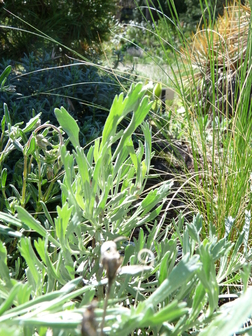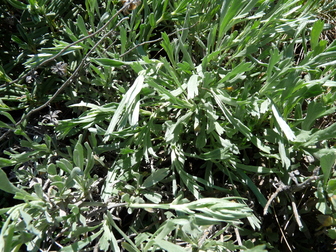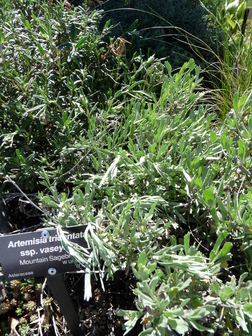Back to Tour: Medicinal Plants Tour
|
Artemisia tridentata ssp. vaseyana Mountain Sagebrush; Mountain Big Sagebrush Artemisia tridentata ssp. vaseyana 070112*2 is no longer in the Denver Botanic Gardens plant collection. |
Denver Botanic Gardens
Gardens Navigator 
|
|
Accession Number: 070112*2 Map | Images | |
| More about Artemisia tridentata ssp. vaseyana | |
| TOUR DETAILS |
Medicinal uses: Medicinally, sagebrush is known to be an antirheumatic, febrifuge (fever-reducer), ophthalmic (helping with eye ailments), and a sedative. A decoction of leaves can be used to treat stomach issues such as indigestion and IBS or a sore throat. An infusion of leaves can be used to treat pneumonia, and bad colds. Research has found that the bitter tea from the leaves acts as a digestive aid, but the volatile oils in some species can lead to permanent nervous disorders with prolonged use. On a positive side, research has found that sagebrush is a menstrual stimulant and vermifuge (expels parasites from the body). A poultice of steeped leaves can be applied to sore eyes for an effective treatment. Infusions of the leaves have also been used as a hair rinse, to combat dandruff. Mythology/Folklore: The name Artemisia comes from a Greek myth, where Artemis, goddess of the moon, gave the power of plants to Chiron the centaur. It was Chiron who was the first person to create medicine out of plants. Native American tribes used the fibrous bark of the sagebrush for weaving. The Shoshone and Paiute tribes used the leaves for helping to ease toothaches. The Coahuila, Hopi and Tewa brewed a tea from the leaves to treat stomach ailments. Navajos wrapped aching joints in bandages made of leaves, and used tea for post-partum pain. Because of sagebrush’s cleansing and healing properties, it was said to ward off evil spirits. In fact, a bundle of dried sagebrush leaves tied together, called a “smudge-stick” is often used to purify ritual areas. Medicinal recipe: Sage-brush Infusion Use a 1:16 ratio (1 ounce of herb to 16 ounces of water). If you’re using dried herbs, dampen them slightly. Wash the leaves, and then place them in a mason jar. Add 16 ounces of a carrier oil, such as olive oil, and make sure the leaves are completely submerged. Allow the mixture to sit for 3 to 4 days, shaking daily. Use this mixture for your hair, as well as a good bug repellent when being outside. Culture: (from Mike Kintgen, staff horticulturalist) Artemisia doesn’t need water after it’s been established. The soil its in should be rocky/gritty and have good drainage. It’s best to start from seed, which are viable for up to three months. Prune if the plant gets too big, but little maintenance is needed. |
| LOCATION GROUP | Rock Alpine Garden; Rock Alpine Garden, South Ledge |
| FAMILY NAME | Aster Family |
| FAMILY | Asteraceae |
| ACCESSION DATE |
January 08, 2007 (When this plant was acquired and registered in the database) |
| FLOWER COLOR | yellow |
| USDA HZ | 4 (Coldest Zone Where Hardy) |
| HABIT | Shrub |
| SOIL | usually in rocky soils |
Location Map for 070112*2 Artemisia tridentata ssp. vaseyana
Map Help
Images © Denver Botanic Gardens
 070112*2 Artemisia tridentata ssp. vaseyana |
 070112*2 Artemisia tridentata ssp. vaseyana |
 070112*2 Artemisia tridentata ssp. vaseyana |
|
| ^Top of Page |

© Denver Botanic Gardens, 1007 York Street, Denver, CO 80206
Photography © Denver Botanic Gardens

Powered by







 E-mail
E-mail